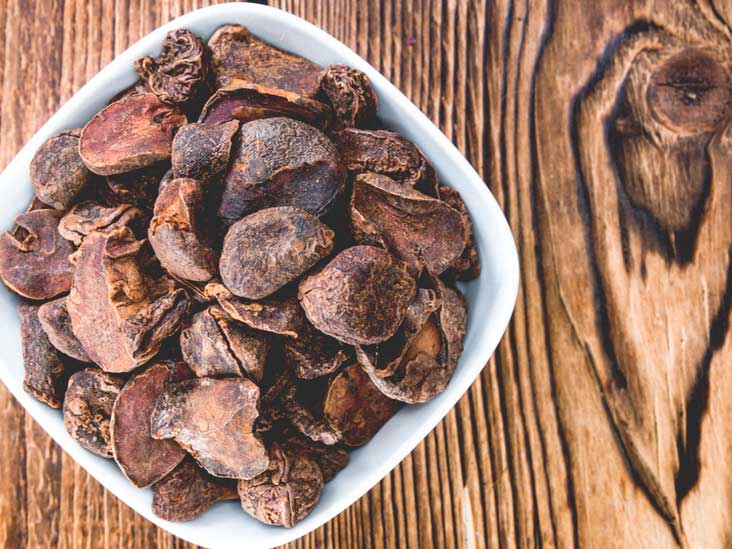At first taste, it is quite bitter, but it eventually ends on a sweet note.
The kola nut, from which the term ‘cola’ derives, is the fruit of species of the kola tree, native to the tropical rainforests of Africa.
The caffeine-containing fruit of this tree has a long history of use in the preparation of beverages in most African societies.
Chewed in many West African cultures since time immemorial – either by individuals or in social settings like weddings, naming ceremonies, and funerals – John Pemberton, a 19th-century American pharmacist, was inspired to combine the kola nut with cocoa, sugar and carbonated water, giving the world the soft drink rightly named Coca-Cola.

Essentially, the name Coca-Cola is derived from two primary ingredients: the coca leaf and the kola nut. Extract of the coca leaf was basically cocaine, and the kola nut provided caffeine.
In West Africa, particularly in parts of Niger, Nigeria, and Liberia, people have long chewed kola nuts as stimulants. This is because the nuts contain caffeine and theobromine, substances that also occur naturally in tea, coffee, and chocolate. They also have sugar and kolanin, said to be a heart stimulant, a recent report by the BBC said.
The kola nut, as a matter of fact, held a lot of value to the extent that in 1581, the ruler of the Songhai Empire in the western Sahel sent to Timbuktu a gift of gold, cowrie shells and, of course, kola nuts during a mosque’s construction, the BBC report said.

Europeans were not aware of the kola nut until the 1500s when Portuguese ships arrived on the coast of what is now Sierra Leone, according to history.
By then, the kola nut trade was in full swing throughout the forests and savannas among the local people. The Portuguese would take part in the trade, carrying nuts down the coast along with other goods.
By the late 19th Century, kola nuts were being shipped by the tonne to Europe and the United States and would begin making millions for them. The nut was now found in tonic medicines acting as a kind of energy boost.
Pemberton, the American chemist from Georgia, would join the fray, creating his own concoction that gave birth to the brown, sweet, fizzy soft drink called Coca-Cola.

The 53-year-old former Confederate officer had then developed an addiction to morphine after being wounded in the Civil War. He, therefore, set out in search of an opium-free substitute. The result would be what he developed at his drugstore in Columbus, Georgia, which served as the prototype for Coca-Cola’s recipe.
Meanwhile, Pemberton’s original Coca-Cola formula, registered in 1885, added a third intoxicant to the party: alcohol. Coca-Cola was originally developed as a coca wine, which was first created in France in the 1860s.
According to J.C. Louis and Harvey Yazijian in their book, The Cola Wars (Everest, 1980), “(Pemberton) had already made some vital changes toward developing a new formula. Eliminating the wine, he added an extract from the African kola nut, a stimulant brought over with the slaves, reputed to work miracles on a hangover. He blended the extract of coca with the kola extract to form a serum base for a new and wondrous ‘Brain Tonic,’ but the bitter taste of his two featured ingredients needed to be masked. . . . In May, he finally hit upon a combination of oils and flavors of the extracts that suited his taste. The result for the serum base was Coca-Cola.”

Essentially, the recipe for the syrup called for coca leaf extract and caffeine from the kola nut, hence, the initial name Coca Kola, but Pemberton’s bookkeeper, Frank Robinson, thought that using two Cs in the name would be striking in advertising. Thus, kola became cola, and the brand name was born.
The first year it was available, about nine servings of Coca-Cola were sold each day across all the Atlanta soda fountains that were often housed in a drug store.
By the late 1890s, the beverage had become one of America’s most popular fountain drinks, and this was largely due to aggressive marketing that was introduced by another Atlanta pharmacist and businessman, Asa Candler, who had bought the formula for Coca-Cola from Pemberton.
Sales of the drink increased by over 4,000 percent between 1890 and 1900. Even though cocaine wasn’t considered illegal until 1914, Candler began removing cocaine from the recipe in the early 1900s.
By 1929, scientists were able to perfect the removal of all psychoactive elements from the coca-leaf extract that was contained in the drink, a report by Thoughtco said.
By the turn of the century, the drink had gone far and was sold across the United States and Canada. Attempts were made in 1985 to change its taste due to declining sales following an increasingly competitive cola market. Consumers rejected the new recipe and within three months, the original cola returned.

Today, about 1.9 billion Cokes are purchased daily, however, it is said to no longer contain kola nut extract. The famed drink relies instead on artificial imitations to achieve the flavour while recipes for making kola soda abound, the BBC report said.
Locally referred to as “goro” in Hausa, the caffeine-based edible seed has, in recent years, been disallowed during Hajj pilgrimage.
In 2016, authorities in Saudi Arabia banned pilgrims from carrying kola nuts to the kingdom during the annual pilgrimage.










